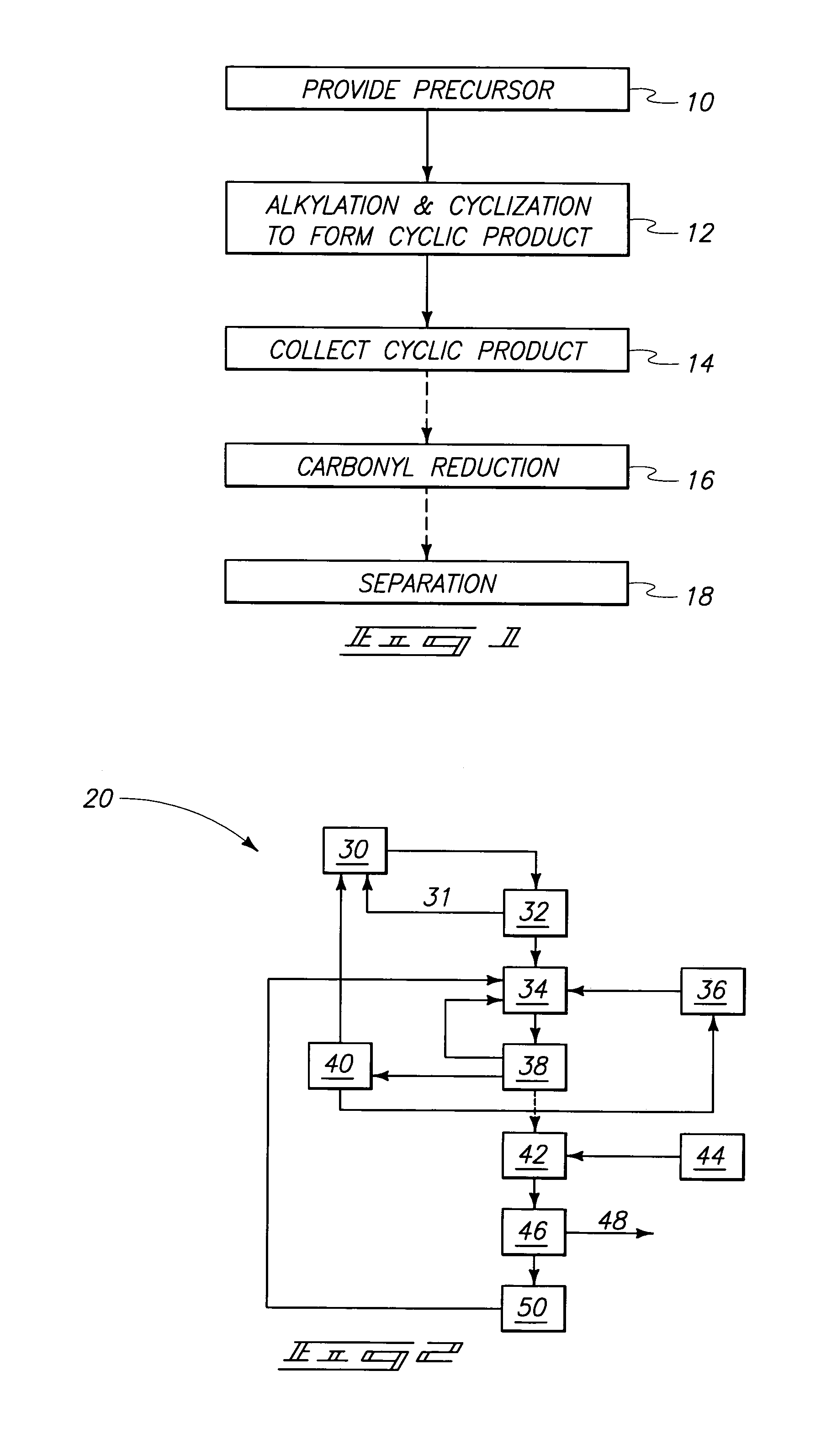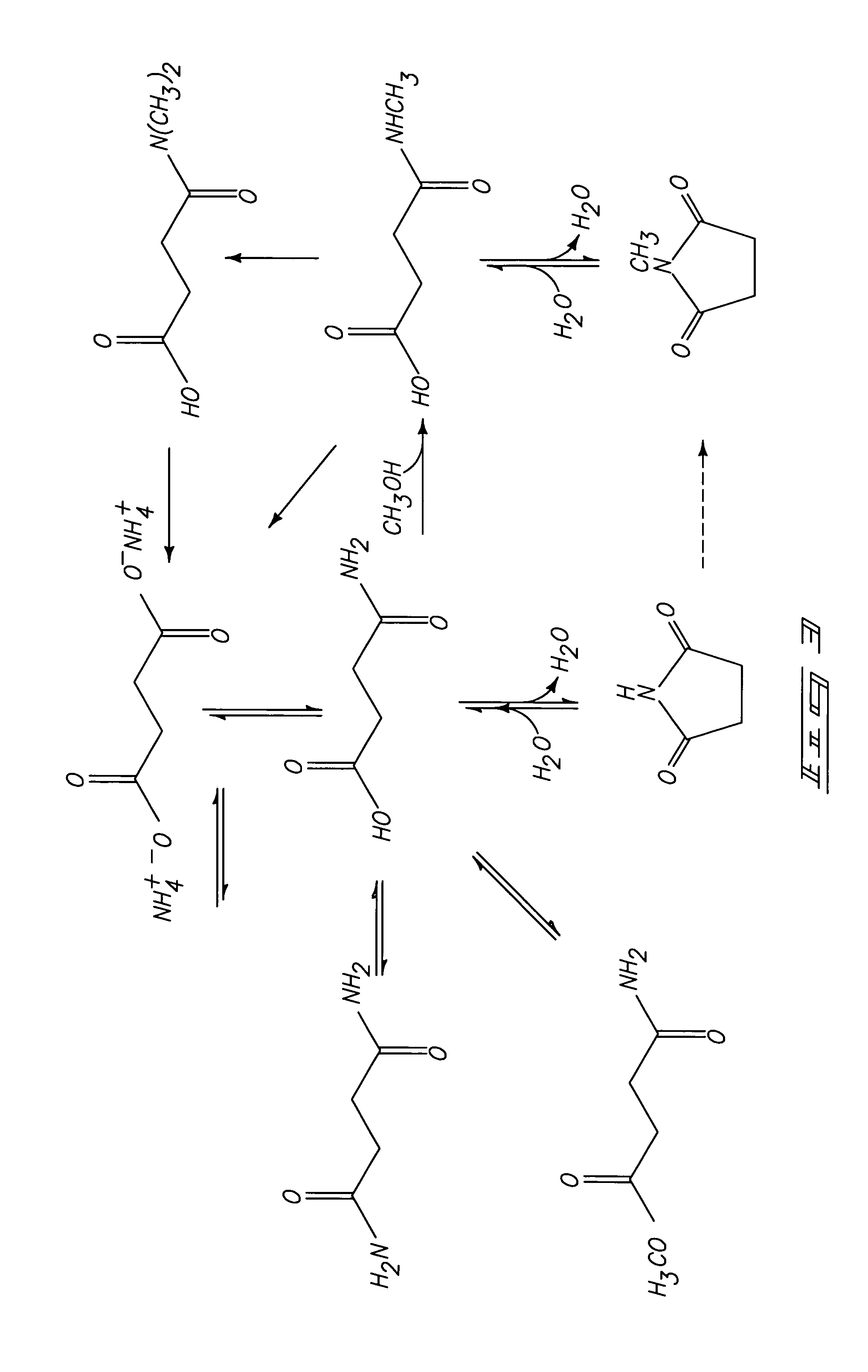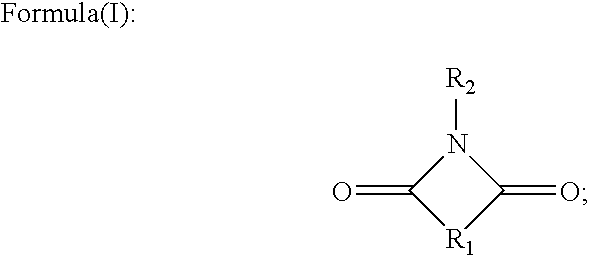Process for producing cyclic compounds
a technology of cyclic compounds and cyclic compounds, which is applied in the field of processing dicarbonyl compounds, can solve the problems of inefficiency and high cost of conventional methods of forming these compounds
- Summary
- Abstract
- Description
- Claims
- Application Information
AI Technical Summary
Benefits of technology
Problems solved by technology
Method used
Image
Examples
example 1
N-methyl Succinimide Formation in the Presence of Fermentation Components
[0058]Ammonium succinate (at a molar ratio of ammonia relative to succinate of 1.2:1) is provided to a reactor in a mixture containing corn steep liquor. The corn steep liquor contains approximately 10% non-water components prior to mixing with ammonium succinate. The mixture is formed to contain approximately 28% ammonium succinate, by weight. Methanol is provided at a methanol to succinate ratio of about 1.5:1. Conversion of ammonium succinate is conducted at 280° C. for 8 hrs. Multiple samples are drawn and results are analyzed to obtain conversion and selectivity information. Analysis after 8 hours indicates a succinate conversion of greater than or equal to 92.9%. The yield of N-methyl succinimide (NMS) is greater than or equal to 70%, with a corresponding production of less than 6.4% N-methyl succinamic acid, less than or equal to 1.7% succinamic acid, and less than 0.5% succinimide.
[0059]A comparison sam...
example 2
Ammonia Adjustment and Thermal Formation of Succinamic Acid from Diammonium Succinate
[0061]Diammonium succinate is provided to a reactor at 50 weight percent in water. The reactor is filled or pressurized with nitrogen and sealed. The sealed reactor is heated to about 200° C. and thereafter samples are collected from the reactor every 10 minutes. The samples are analyzed to determine conversion and selectivity. The results of such analysis are shown in Table 3.
[0062]
TABLE 3Diammonium Succinate Conversion andProduct SelectivitiesElapsedDiammoniumSelectivity toMinutes atSuccinateSuccinamicSelectivity toSelectivity to200° C.Conversion (%)AcidSuccinimidesuccinamideFeed0000 021.684.310.55.21041.778.411.89.82056.874.711.913.43062.773.211.715.14064.872.711.915.45065.373.911.214.9
[0063]The process can produce an ammonia to succinate ratio of about 1.4:1 which is within the preferable range for subsequent formation of N-methyl succinimide. The described method is useful for production of suc...
example 3
N-methyl Succinimide Formation from Succinamic Acid
[0064]Succinamic acid is provided to a reactor at 30% by weight in water. Methanol is provided to the reactor at a 1.5:1 methanol to succinamic acid ratio, and ammonia is added to provide a 0.2:1 ammonia to succinamic acid ratio. This represents a 1.2:1 ammonia to succinate species ratio due to the ammonia integrated into the succinamic acid. The reactor is filled or pressurized with nitrogen and sealed. The reactor is heated to 280° C. and maintained at temperature for 10 hours before quench cooling. The product is analyzed to determine conversion and selectivity products. Analysis after 8 hours indicates a succinamic acid conversion of greater than or equal to 96.5%. The yield of N-methyl succinimide (NMS) is greater than or equal to 77%, with a corresponding production of less than 6.1% N-methyl succinamic acid, less than or equal to 5% succinic acid, and less than 1.7% succinimide.
PUM
| Property | Measurement | Unit |
|---|---|---|
| temperature | aaaaa | aaaaa |
| temperature | aaaaa | aaaaa |
| temperature | aaaaa | aaaaa |
Abstract
Description
Claims
Application Information
 Login to View More
Login to View More - R&D
- Intellectual Property
- Life Sciences
- Materials
- Tech Scout
- Unparalleled Data Quality
- Higher Quality Content
- 60% Fewer Hallucinations
Browse by: Latest US Patents, China's latest patents, Technical Efficacy Thesaurus, Application Domain, Technology Topic, Popular Technical Reports.
© 2025 PatSnap. All rights reserved.Legal|Privacy policy|Modern Slavery Act Transparency Statement|Sitemap|About US| Contact US: help@patsnap.com



